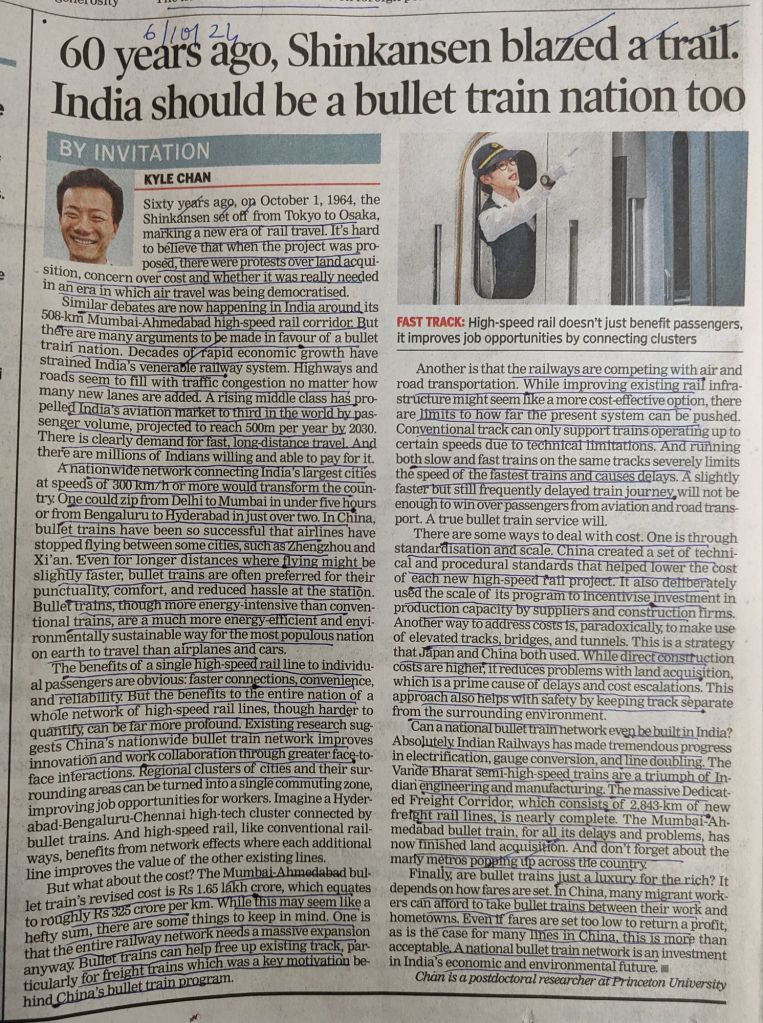Copyright@shravancharitymission
60 YEARS AGO, SHINKANSEN BLAZED A TRAIL. INDIA SHOULD BE A BULLET TRAIN NATION TOO.
BY INVITATION: KYLE CHAN
Sixty years ago, on October 1, 1964, the Shinkansen set off from Tokyo to Osaka, marking a new era of rail travel. It’s hard to believe that when the project was proposed, there were protests over land acquisition, concern over cost and whether it was really needed in an era in which air travel was being democratised.
Similar debates are now happening in India around its 508-km Mumbai-Ahmedabad high speed rail corridor. But there are many arguments to be made in favour of a bullet train nation. Decades of rapid economic growth have strained India’s venerable railway system. Highways and roads seem to be filled with traffic congestion no matter how many new lanes are added. A rising middle class has propelled India’s aviation market to third in the world by passenger volume, projected to reach 500m per year by 2030. There is clearly demand for fast, long-distance travel. And there are millions of Indians willing and able to pay for it.
A nationwide network connecting India’s largest cities at speeds of 300 km/h or more would transform the country. One could zip from Delhi to Mumbai in under five hours or from Bengaluru to Hyderabad in just over two. In China, bullet trains have been so successful that airlines have stopped flying between some cities, such as Zhengzhou and Xi’an. Even for longer distances where flying might be slightly faster, bullet trains are often preferred for their punctuality, comfort, and reduced hassle at the station. Bullet trains, though more energy-intensive than conventional trains, are a much more energy-efficient and environmentally sustainable way for the most populous nation on earth to travel than airplanes and cars.
The benefits of a single high-speed rail line to individual passengers are obvious: faster connections, convenience, and reliability. But the benefits to the entire nation of a whole network of high-speed rail lines, though harder to quantify, can be far more profound. Existing research suggests China’s nationwide bullet train network improves innovation and work collaboration through greater face-to-face interactions. Regional clusters of cities and their surrounding areas can be turned into a single commuting zone, improving job opportunities for workers. Imagine a Hyderabad-Bengaluru-Chennai high-tech cluster connected by bullet trains. And high-speed rail, like conventional railways, benefits from network effects where each additional line improves the value of other existing lines.
But what about the cost? The Mumbai-Ahmedabad bullet train’s revised cost is Rs 1.65 lakh crore, which equates to roughly Rs 325 crore per km. While this may seem like a hefty sum, there are some things to keep in mind. One is that the entire railway network needs a massive expansion anyway. Bullet trains can help free up existing track, particularly for freight trains, which was a key motivation behind China’s bullet train program.
(FAST TRACK: HIGH SPEED RAIL DOESN’T JUST BENEFIT PASSENGERS, IT IMPROVES JOB OPPORTUNITIES BY CONNECTING CLUSTERS)
Another is that the railways are competing with air and road transportation. While improving existing rail infrastructure might seem like a more cost-effective option, there are limits to how far the present system can be pushed. Conventional track can only support trains operating up to certain speeds due to technical limitations. And running both slow and fast trains on the same tracks severely limits the speed of the fastest trains and causes delays. A slightly faster but still frequently delayed train journey will not be enough to win over passengers from aviation and road transport. A true bullet train service will.
There are some ways to deal with the cost. One is through standardisation and scale. China created a set of technical and procedural standards that helped lower the cost of each new high-speed rail project. It also deliberately used the scale of its program to incentivise investment in production capacity by suppliers and construction firms. Another way to address costs is, paradoxically, to make use of elevated tracks, bridges and tunnels. This is a strategy that Japan and China both used. While direct construction costs are higher; it reduces problems with land acquisition, which is a prime cause of delays and cost escalations. This approach also helps with safety by keeping track separate from the surrounding environment.
Can a national bullet train network even be built in India? Absolutely. Indian Railways has made tremendous progress in electrification, gauge conversion, and line doubling. The Vande Bharat semi-high-speed trains are a triumph of Indian engineering and manufacturing. The massive Dedicated Freight Corridor, which consists of 2,843-km of new freight rail lines, is nearly complete. The Mumbai-Ahmedabad bullet train, for all its delays and problems, has now finished land acquisition. And don’t forget about the many metros popping up across the country.
Finally, are bullet trains just a luxury for the rich? It depends on how the fares are set. In China, many migrant workers can afford to take bullet trains between their work and their hometowns. Even if fares are set too low to return a profit, as is the case for many lines in China, this is more than acceptable. A national bullet train network is an investment in India’s economic and environmental future.
(Chan is a postdoctoral researcher at Princeton University)
The Times of India 6/10/24

Posted by Kamlesh Tripathi
Author, Poet, & Columnist
*
https://kamleshsujata.wordpress.com
*
Like it and Share it
*
Shravan Charity Mission is an NGO that works for poor children suffering from life-threatening diseases, especially cancer. Our posts are meant for our readers, including children and adults, and have a huge variety of content. We also accept donations for our mission. Should you wish to donate to the cause of cancer? The bank details are given below:
NAME OF ACCOUNT: SHRAVAN CHARITY MISSION
Account no: 680510110004635 (BANK OF INDIA)
IFSC code: BKID0006805
***














